TRAINING FOR JOBS OF THE FUTURE
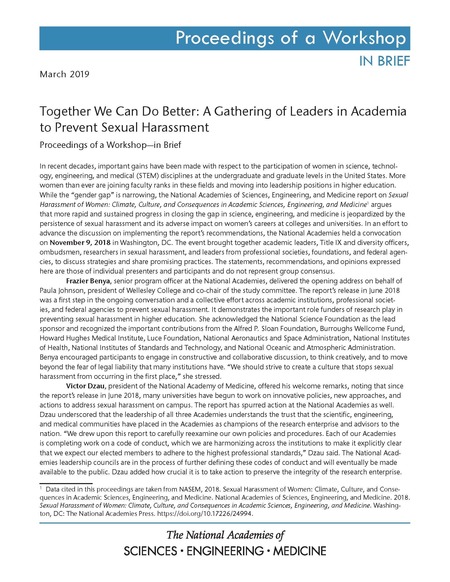 Together We Can Do Better: A Gathering of Leaders in Academia to Prevent Sexual Harassment: Proceedings of a Workshop–in Brief (2019)
Together We Can Do Better: A Gathering of Leaders in Academia to Prevent Sexual Harassment: Proceedings of a Workshop–in Brief (2019)
 Read online free
Read online free  Buy the book or download the free PDF
Buy the book or download the free PDF
In recent decades, important gains have been made with respect to the participation of women in science, technology, engineering, and medical (STEM) disciplines at the undergraduate and graduate levels in the United States. More women than ever are joining faculty ranks in these fields and moving into leadership positions in higher education. While the “gender gap” is narrowing, the National Academies of Sciences, Engineering, and Medicine report Sexual Harassment of Women: Climate, Culture, and Consequences in Academic Sciences, Engineering, and Medicine argues that more rapid and sustained progress in closing the gap in science, engineering, and medicine is jeopardized by the persistence of sexual harassment and its adverse impact on women’s careers at colleges and universities. In an effort to advance the discussion on implementing the report’s recommendations, the National Academies held a convocation on November 9, 2018 in Washington, DC. The event brought together academic leaders, Title IX and diversity officers, ombudsmen, researchers in sexual harassment, and leaders from professional societies, foundations, and federal agencies, to discuss strategies and share promising practices. This publication summarizes the presentations and discussions from the convocation.
 Advancing Economic Development and Workforce Readiness in Micropolitan Areas: Proceedings of a Workshop - in Brief (2018)
Advancing Economic Development and Workforce Readiness in Micropolitan Areas: Proceedings of a Workshop - in Brief (2018)
 Read online free
Read online free  Buy the book or download the free PDF
Buy the book or download the free PDF
Micropolitan areas of the United States, cities with populations between 10,000 and 50,000 people, have received little attention from either the research or policy communities regarding their roles in the U.S. economy. Only recently has attention turned toward small-town America in order to try to characterize and understand the roles micropolitan areas play in productivity, growth, employment and, more broadly, in the innovation system of the nation. Likewise, little research has been undertaken to gain a better understanding of which policy instruments and frameworks can best support economic development and workforce readiness in micropolitan areas.
To explore this topic, the National Academies of Sciences, Engineering, and Medicine held a one-day workshop in Indianapolis in April 2018 on “Advancing Economic Development and Workforce Readiness in Micropolitan Areas” in coordination with the Indiana University Public Policy Institute’s “Thriving Communities, Thriving State” program. This event sought to connect theory to practice by bringing together policy makers, individuals from industry, and researchers across several disciplines to discuss lessons from current research and on-the-ground experience, explore how this knowledge may be utilized to shape policies to effectively support economic development and workforce readiness, and ultimately lay the groundwork for creating a research and knowledge agenda for future work. This publication summarizes the presentations and discussions from the workshop. (Board on Science, Technology and Economic Policy (STEP))
 Building America's Skilled Technical Workforce (2017)
Building America's Skilled Technical Workforce (2017)
 Read online free
Read online free  Buy the book or download the free PDF
Buy the book or download the free PDF  View the video
View the video  View media coverage
View media coverage
Skilled technical occupations—defined as occupations that require a high level of knowledge in a technical domain but do not require a bachelor’s degree for entry—are a key component of the U.S. economy. In response to globalization and advances in science and technology, American firms are demanding workers with greater proficiency in literacy and numeracy, as well as strong interpersonal, technical, and problem-solving skills. However, employer surveys and industry and government reports have raised concerns that the nation may not have an adequate supply of skilled technical workers to achieve its competitiveness and economic growth objectives. (Board on Science, Technology, and Economic Policy (STEP)
 Barriers and Opportunities for 2-Year and 4-Year STEM Degrees: Systemic Change to Support Students' Diverse Pathways (2016)
Barriers and Opportunities for 2-Year and 4-Year STEM Degrees: Systemic Change to Support Students' Diverse Pathways (2016)
 Read online free
Read online free  Buy the book or Download the Free PDF
Buy the book or Download the Free PDF
Nearly 40 percent of the students entering 2- and 4-year postsecondary institutions indicated their intention to major in science, technology, engineering, and mathematics (STEM) in 2012. But the barriers to students realizing their ambitions are reflected in the fact that about half of those with the intention to earn a STEM bachelor’s degree and more than two-thirds intending to earn a STEM associate’s degree fail to earn these degrees 4 to 6 years after their initial enrollment. Many of those who do obtain a degree take longer than the advertised length of the programs, thus raising the cost of their education. Are the STEM educational pathways any less efficient than for other fields of study? How might the losses be “stemmed” and greater efficiencies realized? These questions and others are at the heart of this study. (Board on Science Education/ Board on Higher Education and Workforce)
 Developing a National STEM Workforce Strategy: A Workshop Summary (March 2016)
Developing a National STEM Workforce Strategy: A Workshop Summary (March 2016)
 Read online free
Read online free  Buy the book or download the free PDF
Buy the book or download the free PDF
The future competitiveness of the United States in an increasingly interconnected global economy depends on the nation fostering a workforce with strong capabilities and skills in science, technology, engineering, and mathematics (STEM). STEM knowledge and skills enable both individual opportunity and national competitiveness, and the nation needs to develop ways of ensuring access to high-quality education and training experiences for all students at all levels and for all workers at all career stages. The National Science Foundation (NSF) holds a primary responsibility for overseeing the federal government’s efforts to foster the creation of a STEM-capable workforce. As part of its efforts in this endeavor, NSF funded a workshop that would contribute to its preparation of a theoretical and evidence-based STEM Workforce Development R&D Core Framework. Participants discussed research themes, identified gaps and emerging research opportunities, and recommended refinements in the goals of the framework. This report summarizes the presentations and discussions from the workshop. (Board on Higher Education and Workforce (BHEW)
 Promising Practices for Strengthening the Regional STEM Workforce Development Ecosystem (January 2016)
Promising Practices for Strengthening the Regional STEM Workforce Development Ecosystem (January 2016) Read online free
Read online free  Buy the book or download the free PDF
Buy the book or download the free PDF  View report highlights (PDF)
View report highlights (PDF)
U.S. strength in science, technology, engineering, and mathematics (STEM) disciplines has formed the basis of innovations, technologies, and industries that have spurred the nation’s economic growth throughout the last 150 years. Our understanding, however, of how universities receive, interpret, and respond to industry demands for STEM-trained workers is far from complete. This report examines the extent to which universities and employers in five metropolitan communities (Phoenix, Arizona; Cleveland, Ohio; Montgomery, Alabama; Los Angeles, California; and Fargo, North Dakota) collaborate successfully to align curricula, labs, and other undergraduate educational experiences with current and prospective regional STEM workforce needs. Based on examples from these five regions, the report identifies promising practices to create the kind of university-industry collaboration that promotes higher quality college and university course offerings, lab activities, applied learning experiences, work-based learning programs, and other activities that enable students to be successful in the STEM workforce. (Board on Higher Education and Workforce (BHEW)
 Immigration Policy and the Search for Skilled Workers: Summary of a Workshop (2015)
Immigration Policy and the Search for Skilled Workers: Summary of a Workshop (2015)
 Read online free
Read online free  Buy the book or download the free PDF
Buy the book or download the free PDF
The market for high-skilled workers is becoming increasingly global, as are the markets for knowledge and ideas. While high-skilled immigrants in the United States represent a much smaller proportion of the workforce than they do in countries such as Australia, Canada, and the United Kingdom, these immigrants have an important role in spurring innovation and economic growth in all countries and filling shortages in the domestic labor supply. This report summarizes the proceedings of a fall 2014 workshop that focused on how immigration policy can be used to attract and retain foreign talent. Participants compared policies on encouraging migration and retention of skilled workers, attracting qualified foreign students and retaining them post-graduation, and input by states or provinces in immigration policies to add flexibility in countries with regional employment differences. They also discussed how immigration policies have changed over time in response to undesired labor market outcomes and whether there were sufficient data to measure those outcomes. (Board on Science, Technology, and Economic Policy (STEP)
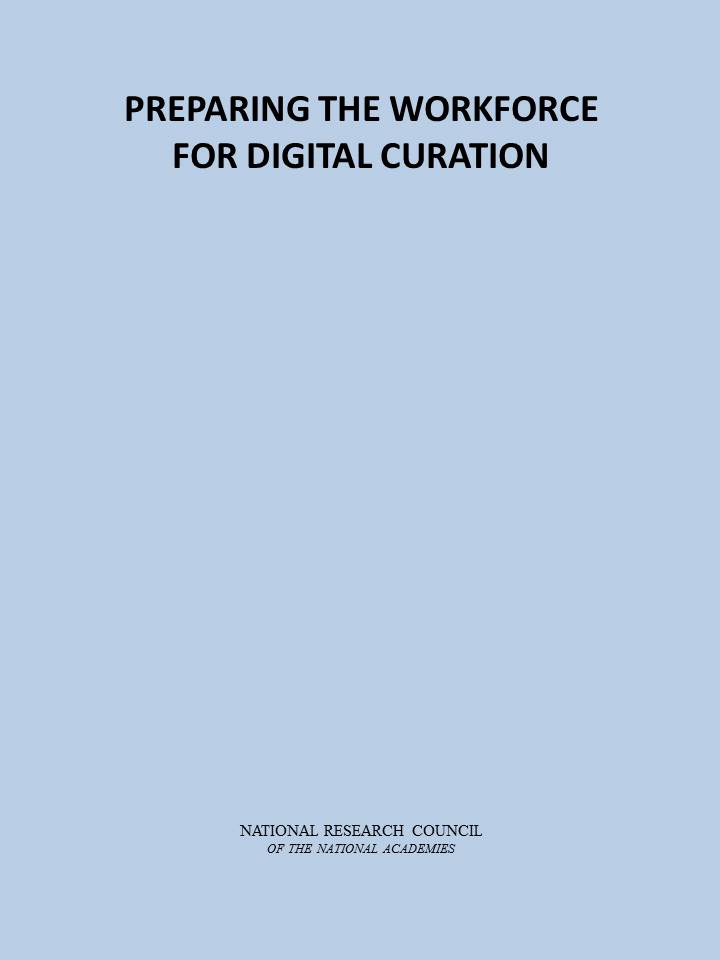 Preparing the Workforce for Digital Curation (April 2015)
Preparing the Workforce for Digital Curation (April 2015)
 Read online free
Read online free  Buy the book or Download the Free PDF
Buy the book or Download the Free PDF  View report highlights (PDF)
View report highlights (PDF)
The massive increase in digital information in the last decade has created new requirements for institutional and technological structures and workforce skills. Preparing the Workforce for Digital Curation focuses on education and training needs to meet the demands for access to and meaningful use of digital information, now and in the future. This study identifies the various practices and spectrum of skill sets that comprise digital curation, looking in particular at human versus automated tasks. Additionally, the report examines the possible career path demands and options for professionals working in digital curation activities, and analyzes the economic benefits and societal importance of digital curation for competitiveness, innovation, and scientific advancement. Preparing the Workforce for Digital Curation considers the evolving roles and models of digital curation functions in research organizations, and their effects on employment opportunities and requirements. The recommendations of this report will help to advance digital curation and meet the demand for a trained workforce. (Board on Research Data and Information (BRDI))
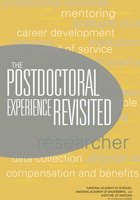 The Postdoctoral Experience Revisited (December 2014)
The Postdoctoral Experience Revisited (December 2014)
 Read online free
Read online free  Buy the book or Download the Free PDF
Buy the book or Download the Free PDF  View media coverage
View media coverage  View the video
View the video  View report highlights (PDF)
View report highlights (PDF)
The Postdoctoral Experience Revisited takes a fresh look at current postdoctoral fellows - how many there are, where they are working, in what fields, and for how many years. This book makes recommendations to improve aspects of programs - postdoctoral period of service, title and role, career development, compensation and benefits, and mentoring. Current data on demographics, career aspirations, and career outcomes for postdocs are limited. This report makes the case for better data collection by research institution and data sharing.
A larger goal of this study is not only to propose ways to make the postdoctoral system better for the postdoctoral researchers themselves but also to better understand the role that postdoctoral training plays in the research enterprise. It is also to ask whether there are alternative ways to satisfy some of the research and career development needs of postdoctoral researchers that are now being met with several years of advanced training. Postdoctoral researchers are the future of the research enterprise. The discussion and recommendations of The Postdoctoral Experience Revisited will stimulate action toward clarifying the role of postdoctoral researchers and improving their status and experience. (Committee on Science, Engineering, Medicine, and Public Policy (COSEMPUP))
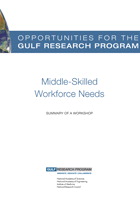 Opportunities for the Gulf Research Program: Middle-Skilled Workforce Needs: Summary of a Workshop (October 2014)
Opportunities for the Gulf Research Program: Middle-Skilled Workforce Needs: Summary of a Workshop (October 2014)
 Read online free
Read online free  Buy the book or Download the Free PDF
Buy the book or Download the Free PDF
During the period 1990 to 2010, U.S. job growth occurred primarily in the high-skilled and low-skilled sectors. Yet, one-third of projected job growth for the period 2010-2020 will require middle-skilled workers -- who will earn strong middle-class wages and salaries -- important to both the production and consumption components of our economy. These jobs typically require significant training, often requiring more than a high school diploma but less than a baccalaureate degree. In the Gulf of Mexico, middle skilled workers play key roles in maintaining oil system safety, completing the numerous environmental restoration projects needed along the Gulf coast, and as workers in an integrated and resilient public health system. Educational pathways that lead to middle skilled jobs in these areas include: apprenticeship programs offered by schools, unions, and employers; high school career and technical education programs; community college courses, certificates, and associate degrees; and employer provided training.
Opportunities for the Gulf Research Program: Middle-Skilled Workforce Needs is the summary of a workshop held on June 9-10, 2014 in Tampa, Florida. This workshop convened 40 thought leaders from the Gulf region's education, employer, and policymaking communities to facilitate a discussion of the current state of education and training pathways for preparing the region's middle-skilled workforce in both the short- and long-term and to identify perceived needs and potential opportunities that might be addressed by the GRP. Workshop participants discussed a variety of opportunities around building capacity in the region's middle-skilled workforce, including the need for competency-based education and training approaches and stronger partnerships among the region's employers and institutions of higher education. (Board on Higher Education and Workforce (BHEW)/Gulf Research Program)
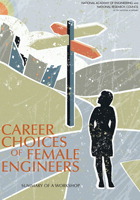 Career Choices of Female Engineers: A Summary of a Workshop (October 2014)
Career Choices of Female Engineers: A Summary of a Workshop (October 2014)
 Read online free
Read online free  Buy the book or Download the Free PDF
Buy the book or Download the Free PDF
Despite decades of government, university, and employer efforts to close the gender gap in engineering, women make up only 11 percent of practicing engineers in the United States. What factors influence women graduates' decisions to enter the engineering workforce and either to stay in or leave the field as their careers progress? Researchers are both tapping existing data and fielding new surveys to help answer these questions.
On April 24, 2013, the National Research Council Committee on Women in Science, Engineering, and Medicine held a workshop to explore emerging research and to discuss career pathways and outcomes for women who have received bachelor's degrees in engineering. Participants included academic researchers and representatives from the Department of Labor, National Science Foundation, and Census Bureau, as well as several engineering professional societies. Career Choices of Female Engineers summarizes the presentations and discussions of the workshop. (Committee on Women in Science, Engineering, and Medicine (CWSEM))
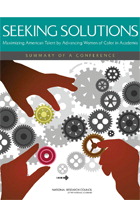 Seeking Solutions: Maximizing American Talent by Advancing Women of Color in Academia: Summary of a Conference (December 2013)
Seeking Solutions: Maximizing American Talent by Advancing Women of Color in Academia: Summary of a Conference (December 2013)
 Read online free
Read online free  Buy the book or Download the Free PDF
Buy the book or Download the Free PDF
Seeking Solutions: Maximizing American Talent by Advancing Women of Color in Academia is the summary of a 2013 conference convened by the Committee on Women in Science, Engineering and Medicine of the National Research Council to discuss the current status of women of color in academia and explore the challenges and successful initiatives for creating the institutional changes required to increase representation of women of color at all levels of the academic workforce. While the number of women, including minority women, pursuing higher education in science, engineering and medicine has grown, the number of minority women faculty in all institutions of higher education has remained small and has grown less rapidly than the numbers of nonminority women or minority men.
Seeking Solutions reviews the existing research on education and academic career patterns for minority women in science, engineering, and medicine to enhance understanding of the barriers and challenges to the full participation of all minority women in STEM disciplines and academic careers. Additionally, this report identifies reliable and credible data source and data gaps, as well as key aspects of exemplary policies and programs that are effective in enhancing minority women's participation in faculty ranks. Success in academia is predicated on many factors and is not solely a function of talent. Seeking Solutions elucidates those other factors and highlights ways that institutions and the individuals working there can take action to create institutional cultures hospitable to people of any gender, race, and ethnicity. (Committee on Women in Science, Engineering, and Medicine (CWSEM))
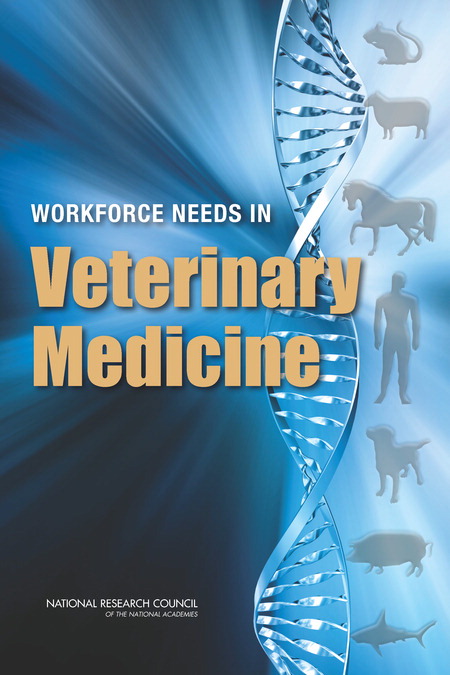 Workforce Needs in Veterinary Medicine
Workforce Needs in Veterinary Medicine
(October 2013)
 Read online free
Read online free  Buy the book or Download the Free PDF
Buy the book or Download the Free PDF  View media coverage
View media coverage
The U.S. veterinary medical profession contributes to society in diverse ways, from developing drugs and protecting the food supply to treating companion animals and investigating animal diseases in the wild. In a study of the issues related to the veterinary medical workforce, including demographics, workforce supply, trends affecting job availability, and capacity of the educational system to fill future demands, a National Research Council committee found that the profession faces important challenges in maintaining the economic sustainability of veterinary practice and education, building its scholarly foundations, and evolving veterinary service to meet changing societal needs.
Many concerns about the profession came into focus following the outbreak of West Nile fever in 1999, and the subsequent outbreaks of SARS, monkeypox, bovine spongiform encephalopathy, highly pathogenic avian influenza, H1N1 influenza, and a variety of food safety and environmental issues heightened public concerns. They also raised further questions about the directions of veterinary medicine and the capacity of public health service the profession provides both in the United States and abroad.
To address some of the problems facing the veterinary profession, greater public and private support for education and research in veterinary medicine is needed. The public, policymakers, and even medical professionals are frequently unaware of how veterinary medicine fundamentally supports both animal and human health and well-being. This report seeks to broaden the public's understanding and attempts to anticipate some of the needs and measures that are essential for the profession to fulfill given its changing roles in the 21st century.(Board on Higher Education and Workforce (BHEW)/Board on Agriculture and Natural Resources (BANR))
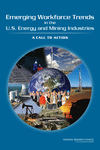 Emerging Workforce Trends in the U.S. Energy and Mining Industries: A Call to Action (March 2013)
Emerging Workforce Trends in the U.S. Energy and Mining Industries: A Call to Action (March 2013)
 Read online free
Read online free  Buy the book or Download the Free PDF
Buy the book or Download the Free PDF  View media coverage
View media coverage
Energy and mineral resources are essential for the nation's fundamental functions, its economy, and security. Nonfuel minerals are essential for the existence and operations of products that are used by people every day and are provided by various sectors of the mining industry. Energy in the United States is provided from a variety of resources including fossil fuels, and renewable and nuclear energy, all with established commercial industry bases. The United States is the largest electric power producer in the world. The overall value added to the U.S. gross domestic product (GDP) in 2011 by major industries that consumed processed nonfuel mineral materials was $2.2 trillion.
Recognizing the importance of understanding the state of the energy and mining workforce in the United States to assure a trained and skilled workforce of sufficient size for the future, the Department of Energy's (DOE's) National Energy technology Laboratory (NETL) contracted with the National Research Council (NRC) to perform a study of the emerging workforce trends in the U.S. energy and mining industries. Emerging Workforce Trends in the U.S. Energy and Mining Industries: A Call to Action summarizes the findings of this study. (Board on Earth Sciences and Resources (BESR)/Board on Higher Education and Workforce (BHEW)/Earth and Life Studies (DELS))
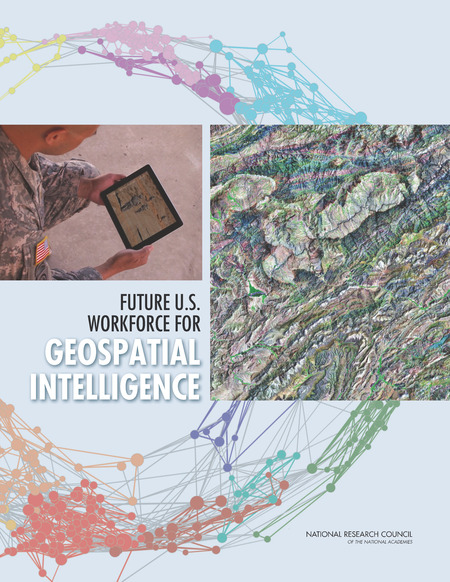 Future U.S. Workforce for Geospatial Intelligence (January 2013)
Future U.S. Workforce for Geospatial Intelligence (January 2013)
 Read online free
Read online free  Buy the book or Download the Free PDF
Buy the book or Download the Free PDF  View media coverage
View media coverage
We live in a changing world with multiple and evolving threats to national security, including terrorism, asymmetrical warfare (conflicts between agents with different military powers or tactics), and social unrest. Visually depicting and assessing these threats using imagery and other geographically-referenced information is the mission of the National Geospatial-Intelligence Agency (NGA). As the nature of the threat evolves, so do the tools, knowledge, and skills needed to respond. The challenge for NGA is to maintain a workforce that can deal with evolving threats to national security, ongoing scientific and technological advances, and changing skills and expectations of workers.
Future U.S. Workforce for Geospatial Intelligence assesses the supply of expertise in 10 geospatial intelligence (GEOINT) fields, including 5 traditional areas (geodesy and geophysics, photogrammetry, remote sensing, cartographic science, and geographic information systems and geospatial analysis) and 5 emerging areas that could improve geospatial intelligence (GEOINT fusion, crowdsourcing, human geography, visual analytics, and forecasting). The report also identifies gaps in expertise relative to NGA's needs and suggests ways to ensure an adequate supply of geospatial intelligence expertise over the next 20 years.. (Board on Earth Sciences and Resources (BESR)/Board on Higher Education and Workforce (BHEW)/Earth and Life Studies (DELS))
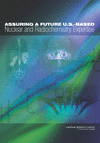 Assuring a Future U.S.-Based Nuclear and Radiochemistry Expertise (November 2012)
Assuring a Future U.S.-Based Nuclear and Radiochemistry Expertise (November 2012)
 Read online free
Read online free  Buy the book or Download the Free PDF
Buy the book or Download the Free PDF  View media coverage
View media coverage
The growing use of nuclear medicine, the potential expansion of nuclear power generation, and the urgent needs to protect the nation against external nuclear threats, to maintain our nuclear weapons stockpile, and to manage the nuclear wastes generated in past decades, require a substantial, highly trained, and exceptionally talented workforce. Assuring a Future U.S.-Based Nuclear and Radiochemistry Expertise examines supply and demand for expertise in nuclear chemistry nuclear science, and radiochemistry in the United States and presents possible approaches for ensuring adequate availability of these skills, including necessary science and technology training platforms.
Considering a range of reasonable scenarios looking to the future, none of these areas are likely to experience a decrease in demand for expertise. However, many in the current workforce are approaching retirement age and the number of students opting for careers in nuclear and radiochemistry has decreased dramatically over the past few decades. In order to avoid a gap in these critical areas, increases in student interest in these careers, in the research and educational capacity of universities and colleges, and sector specific on-the-job training will be needed. Concise recommendations are given for actions to avoid a shortage of nuclear chemistry, nuclear scientists, and radiochemists in the future. (Board on Higher Education and Workforce (BHEW)/Board on Chemical Sciences and Technology (BCST))
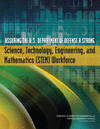 Assuring the U.S. Department of Defense a Strong Science, Technology, Engineering, and Mathematics (STEM) Workforce (October 2012)
Assuring the U.S. Department of Defense a Strong Science, Technology, Engineering, and Mathematics (STEM) Workforce (October 2012)
 Read online free
Read online free  Buy the book or Download the Free PDF
Buy the book or Download the Free PDF  View media coverage
View media coverage
The ability of the nation's military to prevail during future conflicts, and to fulfill its humanitarian and other missions, depends on continued advances in the nation's technology base. A workforce with robust Science, Technology, Engineering and Mathematics (STEM) capabilities is critical to sustaining U.S. preeminence. Today, however, the STEM activities of the Department of Defense (DOD) are a small and diminishing part of the nation's overall science and engineering enterprise.
Assuring the U.S. Department of Defense a Strong Science, Technology, Engineering, and Mathematics (STEM) Workforce presents five principal recommendations for attracting, retaining, and managing highly qualified STEM talent within the department based on an examination of the current STEM workforce of DOD and the defense industrial base. As outlined in the report, DOD should focus its investments to ensure that STEM competencies in all potentially critical, emerging topical areas are maintained at least at a basic level within the department and its industrial and university bases. (Board on Higher Education and Workforce (BHEW)/Engineering and Physical Sciences (DEPS)/National Academy of Engineering (NAE))
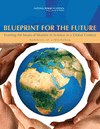 Blueprint for the Future: Framing the Issues of Women in Science in a Global Context: Summary of a Workshop (October 2012)
Blueprint for the Future: Framing the Issues of Women in Science in a Global Context: Summary of a Workshop (October 2012)
 Read online free
Read online free  Buy the book or Download the Free PDF
Buy the book or Download the Free PDF  View media coverage
View media coverage
The scientific work of women is often viewed through a national or regional lens, but given the growing worldwide connectivity of most, if not all, scientific disciplines, there needs to be recognition of how different social, political, and economic mechanisms impact women's participation in the global scientific enterprise. Although these complex sociocultural factors often operate in different ways in various countries and regions, studies within and across nations consistently show inverse correlations between levels in the scientific and technical career hierarchy and the number of women in science: the higher the positions, the fewer the number of women. Understanding these complex patterns requires interdisciplinary and international approaches. In April 2011, a committee overseen by the National Academies' standing Committee on Women in Science, Engineering, and Medicine (CWSEM) convened a workshop entitled, "Blueprint for the Future: Framing the Issues of Women in Science in a Global Context" in Washington, D.C.
CWSEM's goals are to coordinate, monitor, and advocate action to increase the participation of women in science, engineering, and medicine. The scope of the workshop was limited to women's participation in three scientific disciplines: chemistry, computer science, mathematics, and statistics. The workshop presentations came from a group of scholars and professionals who have been working for several years on documenting, analyzing, and interpreting the status of women in selected technical fields around the world. Examination of the three disciplines-chemistry, computer science, and mathematics and statistics-can be considered a first foray into collecting and analyzing information that can be replicated in other fields.
The complexity of studying science internationally cannot be underestimated, and the presentations demonstrate some of the evidentiary and epistemological challenges that scholars and professionals face in collecting and analyzing data from many different countries and regions. Blueprint for the Future: Framing the Issues of Women in Science in a Global Context summarizes the workshop presentations, which provided an opportunity for dialogue about the issues that the authors have been pursuing in their work to date. (Committee on Women in Science, Engineering, and Medicine (CWSEM))
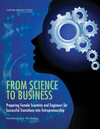 From Science to Business: Preparing Female Scientists and Engineers for Successful Transitions into Entrepreneurship: Summary of a Workshop (August 2012)
From Science to Business: Preparing Female Scientists and Engineers for Successful Transitions into Entrepreneurship: Summary of a Workshop (August 2012)
 Read online free
Read online free  Buy the book or Download the Free PDF
Buy the book or Download the Free PDF
Scientists, engineers, and medical professionals play a vital role in building the 21st century science and technology enterprises that will create solutions and jobs critical to solving the large, complex, and interdisciplinary problems faced by society-problems in energy, sustainability, the environment, water, food, disease, and healthcare. As a growing percentage of the scientific and technological workforce, women need to participate fully not just in finding solutions to technical problems, but also in building the organizations responsible for the job creation that will bring these solutions to market and to bear on pressing issues. To accomplish this, it is important that more women in science and engineering become entrepreneurs in order to start new companies; create business units inside established organizations, mature companies, and the government; and/or function as social entrepreneurs focused on societal issues. Entrepreneurship represents a vital source of change in all facets of society, empowering individuals to seek opportunity where others see insurmountable problems.
From Science to Business: Preparing Female Scientists and Engineers for Successful Transitions into Entrepreneurship is the summary of an August 2009 workshop that assesses the current status of women undertaking entrepreneurial activity in technical fields, to better understand the nature of the barriers they encounter, and to identify what it takes for women scientists and engineers to succeed as entrepreneurs. This report focuses on women's career transitions from academic science and engineering to entrepreneurship, with a goal of identifying knowledge gaps in women's skills as well as experiences crucial to future success in business and critical for achieving leadership positions in entrepreneurial organizations.
From Science to Business makes the case that in addition to educating women scientists and engineers in rigorous problem solving, it is equally important to provide exposure and training to impart the skills that will enable more women to move from the role of expert to that of leader in dynamic new business enterprises. This book will be of interest to professionals in both academia and industry, graduate and post-graduate students, and organizations that advocate for a stronger economy. (Committee on Women in Science, Engineering, and Medicine (CWSEM))
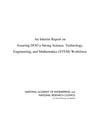 An Interim Report on Assuring DoD a Strong Science, Technology, Engineering, and Mathematics (STEM) Workforce (June 2012)
An Interim Report on Assuring DoD a Strong Science, Technology, Engineering, and Mathematics (STEM) Workforce (June 2012)
 Read online free
Read online free  Buy the book or Download the Free PDF
Buy the book or Download the Free PDF
An Interim Report on Assuring DoD a Strong Science, Technology, Engineering, and Mathematics (STEM) Workforce is a report on the science, technology, mathematics, and engineering (STEM) workforce of the Department of Defense (DOD) and the U.S. defense industrial base is part of an 18-month study to assess the STEM capabilities that the DOD will need in order to meet its goals, objectives, and priorities. This study also assesses whether the current DOD workforce and strategy will meet those needs; and indentifies and evaluates options and recommends strategies that the department could use to help meet its future STEM needs. This study was undertaken by the National Academy of Engineering and the National Research Council.
This report was issued for the purpose of assisting Assistant Secretary of Defense for Research and Engineering with its fiscal year 2012 planning process and with laying the groundwork for future years. Earlier in the project, the Committee on Science, Technology, Engineering, and Mathematics Workforce Needs for the U.S. Department of Defense and the U.S. Defense Industrial Base convened a workshop on August 1 and 2, 2011, in Rosslyn, Virginia. This workshop met for the purpose of gathering a broad range of views from the public sector and the private sector. This includes major defense contractors, and from nongovernmental organizations (NGOs), all of which are stakeholders in the future STEM workforce. At the conclusion of this study, a final report will be released. (Board on Higher Education and Workforce (BHEW)/Engineering and Physical Sciences (DEPS)/National Academy of Engineering (NAE))
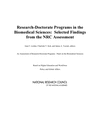 Research Doctorate Programs in the Biomedical Sciences: Selected Findings from the NRC Assessment (July 2011)
Research Doctorate Programs in the Biomedical Sciences: Selected Findings from the NRC Assessment (July 2011)
 Read online free
Read online free  Buy the book or Download the Free PDF
Buy the book or Download the Free PDF
Research Doctorate Programs in the Biomedical Sciences: Selected Findings from the NRC Assessment examines data on the biomedical sciences programs to gather additional insight about the talent, training environment, outcomes, diversity, and international participation in the biomedical sciences workforce. This report supports an earlier publication, A Data-Based Assessment of Research-Doctorate Programs in the United States, which analyzes data and rankings from more than 5,000 doctoral programs, 982 of which were in the biomedical sciences. Research Doctorate Programs in the Biomedical Sciences explores questions about degrees and completion rates as they relate to GRE scores, student funding, program facilities, diversity among faculty members, and other variables. The report examines 11 biomedical science fields including cell and developmental biology, genetics and genomics, microbiology, nutrition, and physiology, among others. (Board on Higher Education and Workforce (BHEW))
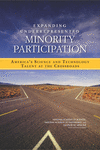
Expanding Underrepresented Minority Participation: America's Science and Technology Talent at the Crossroads (June 2011)
 Read online free
Read online free Buy the book or Download the Free PDF
Buy the book or Download the Free PDF  View media coverage
View media coverage
In order for the United States to maintain the global leadership and competitiveness in science and technology that are critical to achieving national goals, we must invest in research, encourage innovation, and grow a strong and talented science and technology workforce. Expanding Underrepresented Minority Participation explores the role of diversity in the science, technology, engineering and medicine (STEM) workforce and its value in keeping America innovative and competitive. According to the book, the U.S. labor market is projected to grow faster in science and engineering than in any other sector in the coming years, making minority participation in STEM education at all levels a national priority.
Expanding Underrepresented Minority Participation analyzes the rate of change and the challenges the nation currently faces in developing a strong and diverse workforce. Although minorities are the fastest growing segment of the population, they are underrepresented in the fields of science and engineering. Historically, there has been a strong connection between increasing educational attainment in the United States and the growth in and global leadership of the economy. Expanding Underrepresented Minority Participation suggests that the federal government, industry, and post-secondary institutions work collaboratively with K-12 schools and school systems to increase minority access to and demand for post-secondary STEM education and technical training.
The book also identifies best practices and offers a comprehensive road map for increasing involvement of underrepresented minorities and improving the quality of their education. It offers recommendations that focus on academic and social support, institutional roles, teacher preparation, affordability and program development. (Committee on Science, Engineering, Medicine, and Public Policy (COSEMPUP))
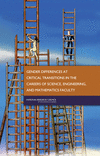 Gender Differences at Critical Transitions in the Careers of Science, Engineering, and Mathematics Faculty (June 2010)
Gender Differences at Critical Transitions in the Careers of Science, Engineering, and Mathematics Faculty (June 2010)
 Read online free,
Read online free,  Download the report brief (PDF)
Download the report brief (PDF)  Buy the book or Download the Free PDF
Buy the book or Download the Free PDF
 View media coverage
View media coverage  View the Summary (PDF; 6.51MB)
View the Summary (PDF; 6.51MB)
This report presents new and surprising findings about career differences between female and male full-time, tenure-track, and tenured faculty in science, engineering, and mathematics at the nation's top research universities. Much of this congressionally mandated book is based on two unique surveys of faculty and departments at major U.S. research universities in six fields: biology, chemistry, civil engineering, electrical engineering, mathematics, and physics. A departmental survey collected information on departmental policies, recent tenure and promotion cases, and recent hires in almost 500 departments. A faculty survey gathered information from a stratified, random sample of about 1,800 faculty on demographic characteristics, employment experiences, the allocation of institutional resources such as laboratory space, professional activities, and scholarly productivity. This book paints a timely picture of the status of female faculty at top universities, clarifies whether male and female faculty have similar opportunities to advance and succeed in academia, challenges some commonly held views, and poses several questions still in need of answers. This book will be of special interest to university administrators and faculty, graduate students, policy makers, professional and academic societies, federal funding agencies, and others concerned with the vitality of the U.S. research base and economy. (Committee on Women in Science, Engineering, and Medicine (CWSEM))
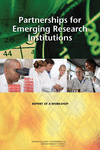 Partnerships for Emerging Research Institutions: Report of a Workshop (March 2009)
Partnerships for Emerging Research Institutions: Report of a Workshop (March 2009)
 Read online free
Read online free  Download the report brief (PDF)
Download the report brief (PDF)  Buy the book or Download the Free PDF
Buy the book or Download the Free PDF
Constituting one-third of all U.S. institutions of higher education, emerging research institutions (ERIs) are crucial to sustaining the nation's technological competitiveness through innovation and workforce development. Many, however, are not fully engaged in sustained sponsored research. This book summarizes the discussions at a workshop that examined the barriers ERIs face in building more robust research enterprises and approaches for overcoming those barriers. The book includes a description of federal programs that focus on capacity building and institutional collaborations. (Government-University-Industry Research Roundtable (GUIRR))
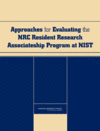
Approaches for Evaluating the NRC Resident Research Associateship Program at NIST (2007)
 Read online free
Read online free  Download the report brief (PDF)
Download the report brief (PDF)  Buy the book or Download the Free PDF
Buy the book or Download the Free PDF
The NRC Resident Research Associateship Program at NIST provides two-year temporary appointments for outstanding scientists and engineers. This report describes program applicants and awardees and offers suggestions for an in-depth assessment of career outcomes. Preliminary investigation indicates that outreach efforts produce more qualified applicants than NIST has slots to fill, the pool of applicants is increasingly diverse, and many Research Associates go on to permanent positions at NIST. The agency should conduct a more thorough evaluation of the program, including an assessment of outreach to potential applicants, individuals who decline an award, the program’s impact on the careers of awardees, and the benefits of the program to NIST and the broader scientific and engineering community. (
Board on Higher Education and Workforce (BHEW))
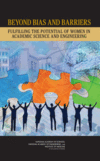
Beyond Bias and Barriers: Fulfilling the Potential of Women in Academic Science and Engineering (2007)
 Read online free
Read online free  Buy the book or Download the Free PDF
Buy the book or Download the Free PDF  Download the report brief (PDF)
Download the report brief (PDF)  Listen the podcast
Listen the podcast
 Download the summary (PDF)
Download the summary (PDF)  View Media Coverage
View Media Coverage
Women scientists and engineers face barriers to success in every field of science and engineering, a record that deprives the country of an important source of talent. Without a transformation of academic institutions to tackle such barriers, the future vitality of the U.S. research base and economy is in jeopardy. Eliminating gender bias in academia requires overarching reform now, including decisive action by university administrators, professional societies, federal funding agencies and foundations, government agencies, and Congress. If implemented and coordinated across public, private, and government sectors, the recommended actions will help to improve workplace environments for all employees while strengthening the foundations of America's competitiveness. (Committee on Science, Engineering, Medicine, and Public Policy (COSEMPUP))
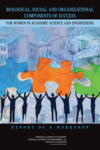 Biological, Social, and Organizational Components of Success for Women in Academic Science and Engineering: Workshop Report (2006)
Biological, Social, and Organizational Components of Success for Women in Academic Science and Engineering: Workshop Report (2006)
 Read online free
Read online free  Buy the book or Download the Free PDF
Buy the book or Download the Free PDF  Download the report brief (PDF)
Download the report brief (PDF)
During the last 40 years, the number of women studying science and engineering (S&E) has increased dramatically. Nevertheless, women do not hold academic faculty positions in numbers that commensurate with their increasing share of the S&E talent pool. The discrepancy exists at both the junior and senior faculty levels. In December 2005, the National Research Council held a workshop to explore these issues. Experts in a number of disciplines met to address what sex-differences research tells us about capability, behavior, career decisions, and achievement; the role of organizational structures and institutional policy; cross-cutting issues of race and ethnicity; key research needs and experimental paradigms and tools; and the ramifications of their research for policy, particularly for evaluating current and potential academic faculty. Biological, Social, and Organizational Components of Success for Women in Academic Science and Engineering consists of three elements: an introduction, summaries of panel discussions including public comment sessions, and poster abstracts. (Committee on Science, Engineering, Medicine, and Public Policy (COSEMPUP))
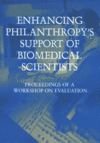
Enhancing Philanthropy's Support of Biomedical Scientists: Proceedings of a Workshop on Evaluation (2006)
 Read online free
Read online free  Buy the book or Download the Free PDF
Buy the book or Download the Free PDF
During an interval of 15 years, the Lucille P. Markey Charitable Trust spent over $500 million on four programs in the basic biomedical sciences that support the education and research of graduate students, postdoctoral fellows, junior faculty, and senior researchers. The Markey Trust asked the NRC to evaluate these programs with two questions in mind: “Were these funds well spent?” and “What can others in the biomedical and philanthropic communities learn from the programs of the Markey Trust, both as an approach to funding biomedical research and as a model of philanthropy?” One of five resulting reports, this volume contains the proceedings of a workshop held in June 2005 to investigate methods used to evaluate funding of the biomedical scientists by philanthropic and public funders. In addition to the Markey Trust, representatives from the Howard Hughes Medical Institute, the American Heart Association, the Doris Duke Charitable Foundation, the National Institutes of Health, and six other funders of biomedical scientists presented information on evaluation methodologies and outcomes. (Board on Higher Education and Workforce (BHEW))
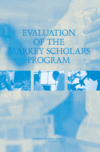 Evaluation of the Markey Scholars Program (2006)
Evaluation of the Markey Scholars Program (2006)
 Read online free
Read online free  Buy the book or Download the Free PDF
Buy the book or Download the Free PDF  Download the report brief (PDF)
Download the report brief (PDF)
Beginning in 1983, the Lucille P. Markey Charitable Trust spent more than $500 million over 15 years in support of students and researchers in the biomedical sciences through several programs. The Trust's Scholar Awards in Biomedical Science focused specifically on providing innovative funding and support to young biomedical researchers spanning the critical transition from postdoctoral training to the first years of a faculty appointment. The Evaluation of the Markey Scholars Program examines the research and career outcomes of the individuals funded as Markey Scholars by comparing indicators of achievement for the Scholars with those for individuals who were unsuccessful applicants for the Scholars award. The study found that the Scholars had a higher level of citations per individual and article, received more R01 grants, achieved higher rank, had a shorter time to tenure, and were located in higher ranked institutions than the biomedical scientists in the comparison groups. The report provides a series of recommendations for structuring future programs that support biomedical scientists who are navigating this critical career transition point. (Board on Higher Education and Workforce (BHEW))
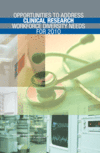 Opportunities to Address Clinical Research Workforce Diversity Needs for 2010 (2006)
Opportunities to Address Clinical Research Workforce Diversity Needs for 2010 (2006)
 Read online free
Read online free  Download the report brief (PDF)
Download the report brief (PDF)  Buy the book or Download the Free PDF
Buy the book or Download the Free PDF
Based on a 2003 workshop, this study describes current public and private programs and recommends ways to recruit and retain more women and underrepresented minorities into clinical research, especially physician-scientists and nurses. Federal sponsors should improve data collection, evaluate existing training programs, and increase the diversity of study section review panels. Public and private sponsors should create funding mechanisms with flexible career paths, and universities and professional societies should both play enhanced roles in fostering diversity. A significant push is needed to recruit minorities into nursing and provide more clinical research training for nurse-scientists, nursing students, and nursing faculty. (Committee on Women in Science, Engineering, and Medicine (CWSEM))
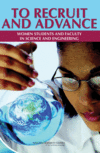 To Recruit and Advance: Women Students and Faculty in U.S. Science and Engineering (2006)
To Recruit and Advance: Women Students and Faculty in U.S. Science and Engineering (2006)
 Read online free
Read online free  Download the report brief (PDF)
Download the report brief (PDF)  Buy the book or Download the Free PDF
Buy the book or Download the Free PDF
Although more women than men participate in higher education in the U.S., the same is not true when it comes to pursuing careers in science and engineering. This guide describes actions actually taken by universities to improve the recruitment, retention, and promotion of women scientists and engineers in academia at all levels, from undergraduate students to senior faculty and administrators. Suggested strategies for improvement are provided separately for faculty, department chairs, deans, and provosts and presidents. (Committee on Women in Science, Engineering, and Medicine (CWSEM))
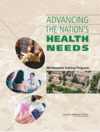 Advancing the Nation's Health Needs: NIH Research Training Programs (2005)
Advancing the Nation's Health Needs: NIH Research Training Programs (2005)
 Read online free
Read online free  Buy the book or Download the Free PDF
Buy the book or Download the Free PDF
This report is the twelfth assessment of the National Institutes of Health National Research Service Awards program. The research training needs of the country in basic biomedical, clinical, and behavioral and social sciences are considered. Also included are the training needs of oral health, nursing, and health services research. The report has been broadly constructed to take into account the rapidly evolving national and international health care needs. The past and present are analyzed, and predictions with regard to future needs are presented. (Board on Higher Education and Workforce (BHEW))
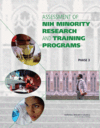 Assessment of NIH Minority Research and Training Programs: Phase 3 (2005)
Assessment of NIH Minority Research and Training Programs: Phase 3 (2005)
 Read online free
Read online free Buy the book or Download the Free PDF
Buy the book or Download the Free PDF
This report provides an assessment of NIH’s programs for increasing the participation in biomedical science of individuals from underrepresented minority groups. The report examines, using available data and the results of a survey of NIH trainees, the characteristics and outcomes of programs at the undergraduate, graduate, postdoctoral, and junior faculty levels. The report provides recommendations for improving these programs and their administration. It also recommends how NIH can improve the data it collects on trainees in all NIH research training programs so as to enhance training program evaluation. (Board on Higher Education and Workforce (BHEW))
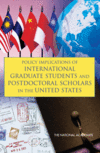 Policy Implications of International Graduate Students and Postdoctoral Scholars in the United States (2005)
Policy Implications of International Graduate Students and Postdoctoral Scholars in the United States (2005)
 Read online free
Read online free  Download the report brief (PDF)
Download the report brief (PDF)  Buy the book or Download the Free PDF
Buy the book or Download the Free PDF
 Download the summary (PDF)
Download the summary (PDF)
Policy Implications of International Graduate Students and Postdoctoral Scholars in the United States explores the role and impact of students and scholars on US educational institutions and the US economy. The nation has drawn increasingly on human resources abroad for its science and engineering workforce. However, competition for talent has grown as other countries have expanded their research infrastructure and created more opportunities for international students. The report discusses trends in international student enrollments, stay rates, and examines the impact of visa policies on international mobility of the highly skilled. (Committee on Science, Engineering, Medicine, and Public Policy (COSEMPUP))
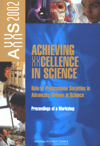 Achieving XXcellence in Science: Role of Professional Societies in Advancing Women in Science: Proceedings of a Workshop, AXXS 2002 (2004)
Achieving XXcellence in Science: Role of Professional Societies in Advancing Women in Science: Proceedings of a Workshop, AXXS 2002 (2004)
 Read online free
Read online free  Download the report brief (PDF)
Download the report brief (PDF)  Buy the book or Download the Free PDF
Buy the book or Download the Free PDF
This report is the proceedings of a July 2002 workshop of the Committee on AXXS 2002: A Workshop for Clinical Societies to Enhance Women's Contributions to Science and their Profession. The workshop gathered representatives of clinical societies and identified ways to enhance the participation of women scientists in the clinical research workforce. This workshop was a follow-up to the AXXS 1999 conference sponsored by the Office of Research on Women's Health (ORWH) at the National Institutes of Health (NIH), which focused on how scientific societies could contribute to the enhancement of women's careers in science. (Committee on Women in Science, Engineering, and Medicine (CWSEM))
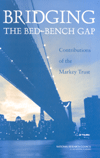 Bridging the Bed-Bench Gap: Contributions of the Markey Trust (2004)
Bridging the Bed-Bench Gap: Contributions of the Markey Trust (2004)
 Read online free
Read online free  Buy the book or Download the Free PDF
Buy the book or Download the Free PDF
Since the 1970s there has been a serious gap between fundamental biological research and its clinical application. In response to this gap the Lucille P. Markey Charitable Trust instituted the General Organizational Grants program, which funded two types of awards to provide training that would bridge the bed-bench gap. These training awards fell into two categories: (1) those that provided significant opportunities for M.D.s to engage in basic research during and immediately following medical school and residency, and (2) those that provided significant clinical exposure for Ph.D.s while they were predoctoral or postdoctoral students. These grants were intended to close the widening gap between rapid advances in our understanding of the biological process and the translation of that knowledge into techniques for preventing diseases. This report examines the General Organizational Grant programs, identifies best practices, and provides observations for future philanthropic funders. (Board on Higher Education and Workforce (BHEW))
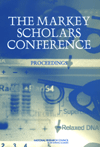 The Markey Scholars Conference: Proceedings (2004)
The Markey Scholars Conference: Proceedings (2004)
 Read online free
Read online free  Buy the book or Download the Free PDF
Buy the book or Download the Free PDF  View media coverage
View media coverage
This is the second of five reports to emerge from the evaluation of the Markey Trust. As part of this assessment, the NRC hosted a scientific conference for Markey Scholars and Visiting Fellows in Rio Grande, Puerto Rico on June 28-30, 2002. The purpose of the conference was to enable the Scholars and Fellows to share their research experiences, just as they did at the annual Scholars Conferences previously conducted by the Markey Trust. All of the attending Scholars and Fellows submitted abstracts of their poster sessions. Six scholars, along with other experts in the biomedical sciences, made formal presentations. These proceedings consist of shortened versions of the individual presentations and the poster session abstracts. (Board on Higher Education and Workforce (BHEW))
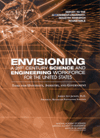 Envisioning A 21st Century Science and Engineering Workforce for the United States: Tasks for University, Industry, and Government (2003)
Envisioning A 21st Century Science and Engineering Workforce for the United States: Tasks for University, Industry, and Government (2003)
 Read online free
Read online free Buy the book or Download the Free PDF
Buy the book or Download the Free PDF
At the request of the Government-University-Industry Research Roundtable (GUIRR), Shirley Ann Jackson, President of Rensselaer Polytechnic Institute, presents in this brief paper her views of the challenges of the 21st century for the science and engineering workforce. Dr. Jackson identifies factors that she believes are contributing to a declining science and engineering workforce, describes the risks and consequences of this decline, and proposes specific, short-term tasks for universities, industry, and the federal government to strengthen and revitalize the workforce. (Government-University-Industry Research Roundtable (GUIRR))
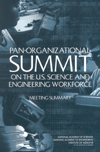 Pan-Organizational Summit on the U.S. Science and Engineering Workforce: Meeting Summary (2003)
Pan-Organizational Summit on the U.S. Science and Engineering Workforce: Meeting Summary (2003)
 Read online free
Read online free  Buy the book or Download the Free PDF
Buy the book or Download the Free PDF
Each of 32 nonprofit organizations contributing a presentation to the Pan-Organizational Summit on the Science and Engineering Workforce (November 11-12, 2002; The National Academies, Washington, DC) was invited to issue a corresponding position paper to be reproduced in this volume. The bulk of this report comprises these papers. In addition, Shirley Jackson and Joseph Toole, two of the keynote speakers, have included their remarks. (Government-University-Industry Research Roundtable (GUIRR))
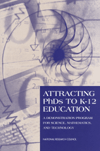 Attracting PhDs to K-12 Education: A Demonstration Program for Science, Mathematics, and Technology (2002)
Attracting PhDs to K-12 Education: A Demonstration Program for Science, Mathematics, and Technology (2002)
 Read online free
Read online free  Buy the book or Download the Free PDF
Buy the book or Download the Free PDF
The National Research Council (NRC) has undertaken a three-phase project to explore the possibility of a program to attract science, mathematics and engineering PhDs to careers in K-12 education. The first phase of the project surveyed the interests of recent PhDs in science and mathematics in pursuing careers in secondary education. Analysis of the Phase I data suggests that a significant percentage of PhDs might be interested in pursuing careers in secondary education under some circumstances. This report from the second phase of the project presents a proposal for a national demonstration program to determine how one might prepare PhDs to be productive members of the K-12 education community. The proposed program is designed to help meet the needs of the nation's schools, while providing further career opportunities for recent PhDs in science, mathematics and engineering. (Board on Higher Education and Workforce (BHEW))
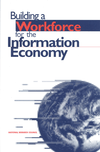 Building a Workforce for the Information Economy (2001)
Building a Workforce for the Information Economy (2001)
 Read online free
Read online free  Buy the book or Download the Free PDF
Buy the book or Download the Free PDF
Building a Workforce for the Information Age offers an in-depth look at information technology workers, where they work and what they do, illuminating key areas that have been raised in political debates: Where do people in IT jobs come from? What kind of education and training matter most for them? Does the labor market—and the experiences of employers and workers—differ in various parts of the country? How do citizens of other countries factor into the U.S. IT workforce? What do we know about IT career paths, and what does that imply for IT workers as they age? And can we measure what matters? The study identifies characteristics that differentiate IT work from other categories of high-tech work and also looks at the capacity of the U.S. educational system and of employer training programs to produce qualified workers. (
Board on Higher Education and Workforce (BHEW))
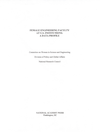 Female Engineering Faculty at U.S. Institutions: A Data Profile
Female Engineering Faculty at U.S. Institutions: A Data Profile (2001)
 Read online free
Read online free Buy the book or Download the Free PDF
Buy the book or Download the Free PDF
Several federal agencies asked the National Research Council to document the participation of women engineers in academic institutions within the United States by creating a directory that can be used to announce programs and other formal communications. In response, the NRC compiled a list of approximately 1,300 women faculty in engineering departments in the United States and conducted a survey to gather additional information about their status and careers. This resulting data profile provides information on the race/ethnicity, degrees held, employment history, primary work activities, and tenure status of the nearly 800 women faculty members who completed the survey. In addition, it summarizes their responses to questions about experiences with mentoring, factors contributing to career decisions, and satisfaction with current employment. (
Committee on Women in Science, Engineering, and Medicine (CWSEM))
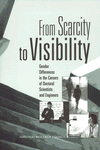 From Scarcity to Visibility: Gender Differences in the Careers of Doctoral Scientists and Engineers
From Scarcity to Visibility: Gender Differences in the Careers of Doctoral Scientists and Engineers (2001)
 Read online free
Read online free  Download the report brief (PDF)
Download the report brief (PDF)  Buy the book or Download the Free PDF
Buy the book or Download the Free PDF View the Summary (PDF; .26MB)
View the Summary (PDF; .26MB)
Although women have made important inroads in science and engineering since the early 1970s, their progress in these fields has stalled over the past several years. This study looks at women in science and engineering careers in the 1970s and 1980s, documenting differences in career outcomes between men and women and between women of different races and ethnic backgrounds. The panel presents what is known about the following questions and explores their policy implications: In what sectors are female Ph.D.s employed? What salary disparities exist between men and women in these fields? How is marital status associated with career attainment? Does it help a career to have a postdoctoral appointment? How well are female scientists and engineers represented in management?
Within the broader context of education and the labor market, the book provides detailed comparisons between men and women Ph.D.s in a number of measures: financial support for education, academic rank achieved, salary, and others. The study covers engineering; the mathematical, physical, life, and social and behavioral sciences; medical school faculty; and recipients of National Institutes of Health grants. Findings and recommendations in this volume will be of interest to practitioners, faculty, and students in science and engineering as well as education administrators, employers, and researchers in these fields. (
Committee on Women in Science, Engineering, and Medicine (CWSEM))
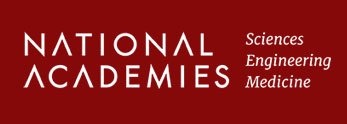









 The Postdoctoral Experience Revisited (December 2014)
The Postdoctoral Experience Revisited (December 2014) Opportunities for the Gulf Research Program: Middle-Skilled Workforce Needs: Summary of a Workshop (October 2014)
Opportunities for the Gulf Research Program: Middle-Skilled Workforce Needs: Summary of a Workshop (October 2014)

 Workforce Needs in Veterinary Medicine
Workforce Needs in Veterinary Medicine 
 Future U.S. Workforce for Geospatial Intelligence (January 2013)
Future U.S. Workforce for Geospatial Intelligence (January 2013)


 From Science to Business: Preparing Female Scientists and Engineers for Successful Transitions into Entrepreneurship: Summary of a Workshop (August 2012)
From Science to Business: Preparing Female Scientists and Engineers for Successful Transitions into Entrepreneurship: Summary of a Workshop (August 2012) An Interim Report on Assuring DoD a Strong Science, Technology, Engineering, and Mathematics (STEM) Workforce (June 2012)
An Interim Report on Assuring DoD a Strong Science, Technology, Engineering, and Mathematics (STEM) Workforce (June 2012) Research Doctorate Programs in the Biomedical Sciences: Selected Findings from the NRC Assessment (July 2011)
Research Doctorate Programs in the Biomedical Sciences: Selected Findings from the NRC Assessment (July 2011)





 Biological, Social, and Organizational Components of Success for Women in Academic Science and Engineering: Workshop Report (2006)
Biological, Social, and Organizational Components of Success for Women in Academic Science and Engineering: Workshop Report (2006)
 Evaluation of the Markey Scholars Program (2006)
Evaluation of the Markey Scholars Program (2006)
 To Recruit and Advance: Women Students and Faculty in U.S. Science and Engineering (2006)
To Recruit and Advance: Women Students and Faculty in U.S. Science and Engineering (2006)










